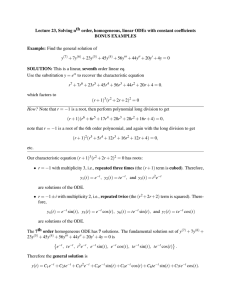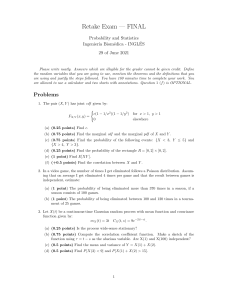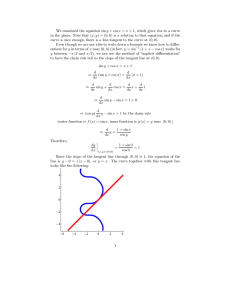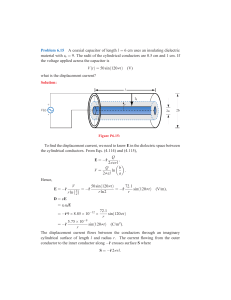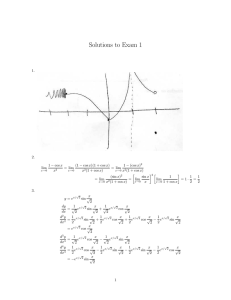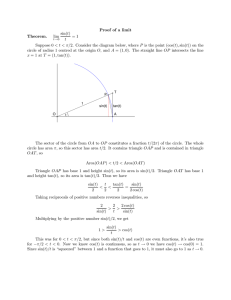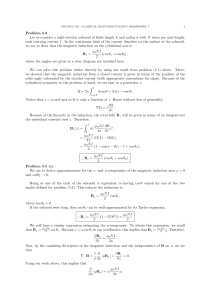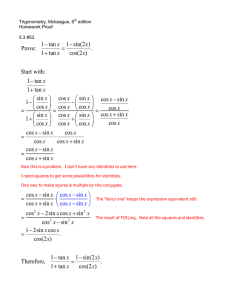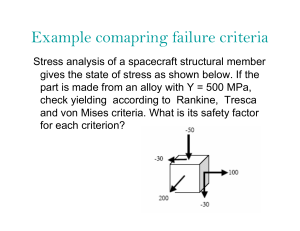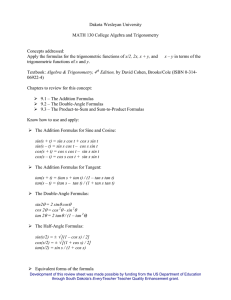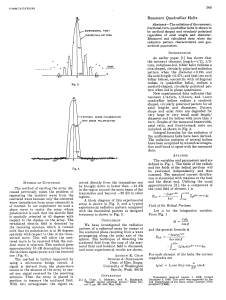THE UNION OF VIETA AND WALLIS PRODUCTS FOR PI
Anuncio
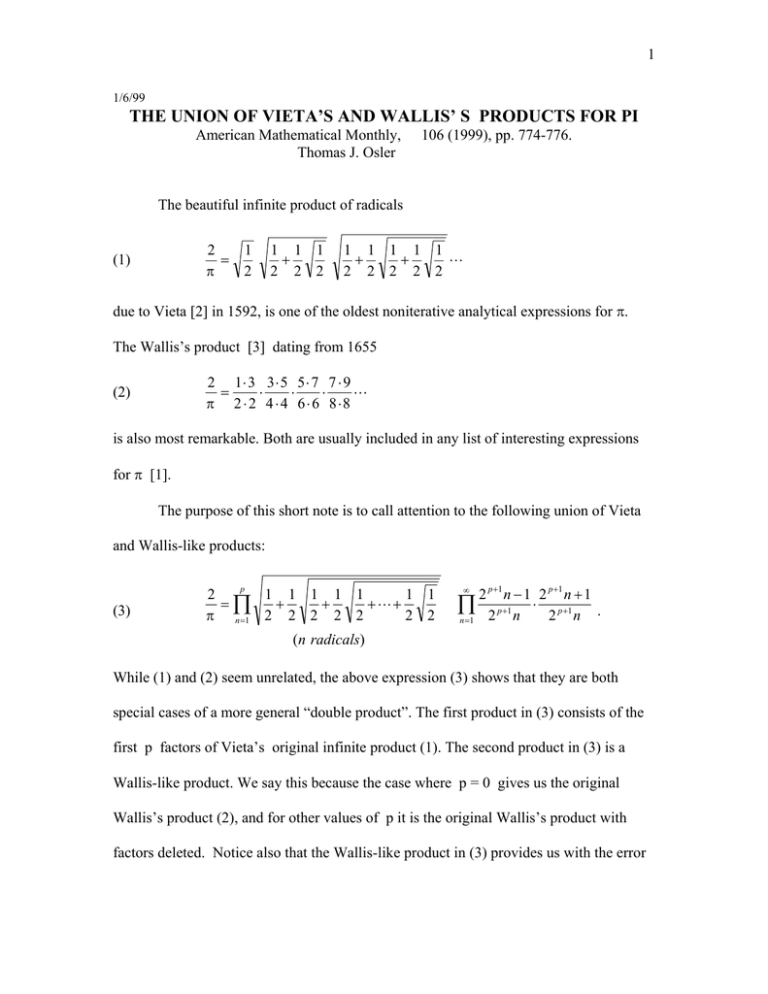
1 1/6/99 THE UNION OF VIETA’S AND WALLIS’ S PRODUCTS FOR PI American Mathematical Monthly, Thomas J. Osler 106 (1999), pp. 774-776. The beautiful infinite product of radicals 2 = π (1) 1 2 1 1 1 + 2 2 2 1 1 1 1 1 + + ⋅⋅⋅ 2 2 2 2 2 due to Vieta [2] in 1592, is one of the oldest noniterative analytical expressions for π. The Wallis’s product [3] dating from 1655 2 1⋅ 3 3 ⋅ 5 5 ⋅ 7 7 ⋅ 9 = ⋅ ⋅ ⋅ ⋅⋅⋅ π 2 ⋅ 2 4 ⋅ 4 6⋅ 6 8⋅8 (2) is also most remarkable. Both are usually included in any list of interesting expressions for π [1]. The purpose of this short note is to call attention to the following union of Vieta and Wallis-like products: (3) p 2 1 1 1 1 1 1 1 =∏ + + + ⋅⋅⋅ + 2 2 π n =1 2 2 2 2 2 2 p +1 n − 1 2 p +1 n + 1 ⋅ p +1 ∏ 2 p +1 n 2 n . n =1 ∞ (n radicals) While (1) and (2) seem unrelated, the above expression (3) shows that they are both special cases of a more general “double product”. The first product in (3) consists of the first p factors of Vieta’s original infinite product (1). The second product in (3) is a Wallis-like product. We say this because the case where p = 0 gives us the original Wallis’s product (2), and for other values of p it is the original Wallis’s product with factors deleted. Notice also that the Wallis-like product in (3) provides us with the error 2 factor needed to make the Vieta product (1) exact when only a finite number of factors are used . Relation (3) yields Vieta’s product (1) as the limiting case as p goes to infinity, and the Wallis’s product (2) as the case p=0. For each intermediate value of p = 1, 2, 3, ... we obtain “united Vieta-Wallis-like products”: p=0: 2 1⋅ 3 3 ⋅ 5 5 ⋅ 7 7 ⋅ 9 9 ⋅ 11 11⋅ 13 = ⋅ ⋅ ⋅ ⋅ ⋅ ⋅⋅⋅ (original Wallis’s product) π 2 ⋅ 2 4 ⋅ 4 6 ⋅ 6 8 ⋅ 8 10 ⋅ 10 12 ⋅ 12 p=1: 2 = π 1 3 ⋅ 5 7 ⋅ 9 11⋅ 13 15 ⋅ 17 19 ⋅ 21 ⋅ ⋅ ⋅ ⋅ ⋅ ⋅⋅⋅ 2 4 ⋅ 4 8 ⋅ 8 12 ⋅ 12 16 ⋅ 16 20 ⋅ 20 p=2: 2 = π 1 1 1 1 7 ⋅ 9 15 ⋅ 17 23 ⋅ 25 31 ⋅ 33 ⋅ + ⋅ ⋅ ⋅ ⋅ ⋅⋅⋅ 2 2 2 2 8 ⋅ 8 16 ⋅ 16 24 ⋅ 24 32 ⋅ 32 p=3: 2 = π 1 1 1 1 ⋅ + 2 2 2 2 1 1 1 1 1 15 ⋅ 17 31⋅ 33 47 ⋅ 49 63 ⋅ 65 + + ⋅ ⋅ ⋅ ⋅ ⋅⋅⋅ 2 2 2 2 2 16 ⋅ 16 32 ⋅ 32 48 ⋅ 48 64 ⋅ 64 2 = π 1 2 1 1 1 1 1 + + ⋅⋅⋅ (Vieta’s original product). 2 2 2 2 2 ... p→ ∞ : 1 1 1 + 2 2 2 An examination of the above special cases of (3) shows that each time we increase p by one, we increase the Vieta’s product by one new radical factor, and remove alternate factors from the Wallis-like product. The author accidentally discovered our main result (3) while trying to derive Vieta’s product (1). To derive (3) we start by applying the double angle formula for the sine function p times to obtain θ θ sin θ = 2 cos sin 2 2 3 θ θ θ = 2 2 cos cos 2 sin 2 2 2 2 θ θ θ θ = 2 3 cos cos 2 cos 3 sin 3 2 2 2 2 ... (4) θ θ θ θ θ sin θ = 2 p cos cos 2 cos 3 ⋅⋅⋅ cos p sin p 2 2 2 2 2 Next we use the infinite product for the sine function [4], (valid for all x), F x IJ = x∏ FG πn − x ⋅ πn + x IJ sin x = x ∏ G 1 − H πn πn K H πnK ∞ ∞ 2 n =1 2 2 n =1 with x = θ / 2 p to replace the last factor in (4). We get after dividing by θ (5) sin θ θ θ θ θ = cos cos 2 cos 3 ⋅⋅⋅ cos p 2 2 2 2 θ F 2 π n − θ 2 πn + θ I ∏ GH 2 πn ⋅ 2 πn JK . ∞ n =1 p p p p We evaluate each of the cosine factors in (5) in terms of cosθ by repeated use of the half-angle formula for the cosine. (Here we will assume −π / 2 ≤ θ ≤ π / 2 so that the cosines are never negative.) cos θ 1 1 = + cosθ 2 2 2 cos θ = 22 1 1 1 1 + + cosθ 2 2 2 2 ... (6) cos θ 1 1 1 1 1 1 1 1 = + + + ⋅⋅⋅ + + cosθ p 2 2 2 2 2 2 2 2 2 b p radicalsg Combining (6) with (5) we obtain 4 (7) p sin θ 1 1 1 1 1 1 1 1 =∏ + + + ⋅⋅⋅ + + cosθ θ 2 2 2 2 2 2 2 2 n =1 F 2 πn − θ 2 πn + θ I ∏ GH 2 πn ⋅ 2 πn JK ∞ p n =1 p p p (n radicals) If we set θ = π / 2 in (7) and simplify we obtain our united Vieta-Wallis formula (3). This completes our proof. References 1. L. Berggren, J. Borwein and P. Borwein, Pi, A Source Book, Springer, New York, 1997, pp. 686-689. 2. F. Vieta, Variorum de Rebus Mathematicis Reponsorum Liber VII, (1593) in: Opera Mathematica, (reprinted) Georg Olms Verlag, Hildesheim, New York, 1970, pp. 398-400 and 436-446. 3. J. Wallis, Computation of π by Successive Interpolations, (1655) in: A Source Book in Mathematics, 1200-1800 (D. J. Struik, Ed.), Harvard University Press, Cambridge, MA, 1969, pp. 244-253. 4. E. T. Whittaker and G. N. Watson, A Course of Modern Analysis, Cambridge University Press, Fourth Ed., 1927, p. 137. Mathematics Department, Rowan University, Glassboro, NJ 08028 [email protected]
